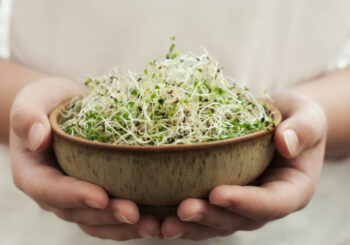Guest Writers for Wake Up World
Sprouts. They are delicate, tasty, and delicious! But did you know that they are also packed with nutrition, protein, gut-healthy enzymes, and key vitamins and minerals? What’s more, they are super easy and fun to grow! Here is all you need to know about these nutrient-packed morsels and how you can grow them yourself.
My Sprout Obsession
I will let you in on a little secret. I’ve been eating greens, baby greens, and even microgreens for quite a while now. I try to get some of these greens every day, and most of the time, maybe like you, I just go into my local natural health grocery store or farmers market and pick some up.
I started growing sprouts not too long ago. Ask anyone in the Bollinger household and you’ll find out that I’m now pretty obsessed with growing them. In fact, my “little sprouting project” is taking up an entire table in our basement. I think it is a good obsession though, not just physically but mentally as well. Preparing them and caring for them as they develop can be a meditative practice.
Also, I am amazed at how little space they take up as they grow. And within 2-3 days, I get to eat them (and everyone else around the table does as well)!
Be sure to check out the last section of this article for the 411 on the easiest way to grow sprouts on your own. Growing your own sprouts is absolutely the best (and most economical) way to get your sprouts in every day.
Greens, Microgreens, Baby Greens, and Sprouts
Sprouts are sometimes lumped together in the same category as “microgreens.” However, there is a distinct difference between the two. Micronutrients are green, leafy vegetables (like romaine or kale) that have been growing for about three weeks. They have developed their first tiny leaves, although these leaves are not as developed as they are with baby greens. Microgreens are about 1-3 inches tall.
Sprouts, on the other hand, are consumed after just 2-7 days and have not developed any leaves at all.
What microgreens and sprouts have in common is a wealth of phytonutrients packed into a very small container. As we shall see, however, sprouts have significantly more of those same nutrients.
What Is So Big About Little Sprouts?
Do you want the most “bang for your buck” when it comes to life-giving phytonutrients, vitamins, minerals, and enzymes from food? Get some sprouts in your diet every day! To show you just how nutritious sprouts really are, here is a breakdown of some of the nutritional content found in sprouts:
1 | Enzymes
One of the greatest benefits of eating sprouts is the enzyme content found within them. These enzymes not only help your digestive system to break down the sprouts; they also help you break down and absorb all of your food.
There have also been fascinating studies which associated the antioxidant activity in sprouts with mechanisms that were able to regulate the workings of other enzymes. In particular, a University of Massachusetts study found that sprouts that were germinated for just a short amount of time (2-3 days, for example) had the ability to regulate the enzyme amylase.
Amylase is used in the breakdown of sugars and is usually in extreme dysregulation amongst Type II Diabetics. The metabolic effects of sprouts led the researchers to the obvious conclusion that eating sprouts may be good for helping with some of the key metabolic symptoms of diabetes.
2 | Vitamins
Of course, different kinds of sprouts are going to have different types of key nutrients. In general, however, most sprouts are generally high in vitamins A, C, D, E, and K. Sprouts, in general, are also high in many different forms of B vitamins, including folate (B9), thiamin (B1), pantothenic acid (B5), and riboflavin (B2). They also have a decent amount of choline, which can support the liver, as well as betaine, which helps with protein synthesis.
3 | Minerals
The mineral content in most sprouts is also very high. Key minerals that are found in most sprouts include calcium, iron, magnesium, zinc, manganese, copper, and manganese.
4 | Amino Acids
Amino acids are the building blocks of collagen, which in turn is the building block of healthy tissue growth and repair. If you are interested in looking and feeling younger as you age, then replenishing your collagen supply by getting in some extra essential amino acids in your diet every day is a good idea.
Sprouts have been shown to have a lot more amino acid content than fully grown veggies (up to 30% more according to one study). Another investigation published in the Journal of the Science of Food and Agriculture found that seed germination resulted in higher levels of lysine, methionine, leucine, isoleucine, threonine, phenylalanine, and valine.
5 | Protein
Amino acids are also the basic substances that make up proteins in the body. Since sprouts are packed with amino acids, it makes sense that they would be packed with high amounts of protein as well. Sprout varieties that are the highest in protein are bean sprouts, especially lentils. Sunflower seed sprouts also contain one of the highest protein levels as well.
According to recent research, sprouts, in general, have been connected to benefits for the heart, bones, and detoxification pathways. And as we will see a little bit later, some sprout types actually have anti-cancer substances within them.
Four of the Most Popular and Easy-to-Grow Sprout Varieties
There are dozens of varieties of sprouts out there. Actually, since a sprout is just a newborn plant; any seed, pit, or nut can be sprouted. Here are a few of the most popular ones. These are also the ones that have been analyzed most for their specific nutritional content:
1 | Alfalfa
Alfalfa sprouts are pretty well-known in the West. These delicate sprouts come from tiny seeds that produce tiny shoots. They can be a refreshing addition to everything from sandwiches to garnishes for soups. Alfalfa sprouts come from alfalfa wheat and have a large amount of nutrients that can be beneficial for bone strength.
Amongst the nutritional content of alfalfa is a high amount of both calcium and vitamin K. In a study sponsored in part by the U.S. Department of Agriculture (USDA) and Tufts University, “regular consumption” of alfalfa sprouts helped both women and men prevent the beginnings of osteoporosis.
2 | Sunflower
Sunflower seeds are good for more than just road food. You can also sprout them! When you do, you are getting a protein-packed snack since sunflower seed sprouts contain about 25% protein (one of the highest amongst all sprouts).
Sunflower sprouts are also good for the immune system. They contain high amounts of zinc, vitamin B, and vitamin D. In Ayurveda, nutrient-dense sprouts such as sunflower sprouts are said to be good for clearing out congestion and quite beneficial for the lungs in general.
3 | Radish Sprouts
All sprouts are great to eat when you want to support your detoxification pathways. Radish sprouts, however, are especially beneficial for clearing out and strengthening the liver and removing gallstones.
This is because radishes have been found to have substances, especially in their leaves, that can help with the removal of bilirubin. Bilirubin is a yellowish-brown fluid that is created through the breakdown of red blood cells. It is one of the key ingredients in bile.
Some studies also suggest that radish can kickstart enzymatic processes which are key for both Phase I and Phase II liver detoxification.
Radish sprouts have a spicy flavor that is refreshing and delightful for people who like a little zest with their meal!
4 | Bean Sprouts
There are several different kinds of bean sprouts that are popular these days. Lentil, mung, garbanzo, and soybean are just a few. Most bean sprouts have big shoots and a hearty flavor, so they make a great addition to stir-fries and even coleslaws.
One of the most awesome things about bean sprouts when it comes to nutrition is their high protein content. Bean sprouts have higher levels of vitamin C and folate (B9) than regular cooked beans. This makes them a hearty source of DNA-repairing antioxidants.
There are benefits for each type of bean. Mung beans are extremely hearty, so they are super easy and fast to grow. Want to go from dried beans to sprouts on your plate in 2 days? Go for the mungs!
Lentils take a little more time to grow (at least 10 days). On the other hand, lentils have a very high protein content and are fairly low in calories, which makes them great for weight loss.
Grow Your Sprouts in 4 Easy Steps
All sprouts, including broccoli sprouts, are pretty easy to grow. What’s more, they don’t take up much space or time. This makes them a great growing option for busy folks or those who live in apartments or condos.
Here are some basic supplies you are going to want to have on hand before you start sprouting:
- Glass jars (wide mouth quart mason jars are great for sprouting), or a plastic sprouting container
- If you’re using a jar – screens, cheesecloth, or a screened lid (this is to cover the opening of the jar to protect them from bugs but also to allow airflow. Most natural health stores sell screened lids that usually fit over quart-sized mason jars)
- Rubber bands (if you are using a screen or a cheesecloth, then the rubber bands will keep this material secure on the top of the jar)
- A dark colored towel
- A location that gets filtered light (if you are doing seeds).
- Between 2 teaspoons and 2 tablespoons of the beans or seeds you want to sprout. The exact amounts will depend on the initial seed or bean. Be sure to read up on how much you need for the size of your jar so that you don’t overpopulate!
Here are the basics of how to sprout in general:
1 | Rinse and then soak the beans or seeds overnight (or for several hours during the day).
Be sure that all seeds or beans are covered with water. This usually means keeping at least two inches of water above the sprouting material. Be sure to use filtered water for soaking.
2 | Drain the water and place the beans or seeds gently into a clean mason jar.
Cover the jar with the lid or cloth/screen. Lay the jar on its side and distribute the seeds or beans along the bottom so that they are not too stacked on each other.
Also, keep the opening of the jar unblocked so that there is plenty of space for air to flow in and out. It is best to put the jar on a cookie sheet or some other portable, flat surface since some water will remain from the soaking.
3 | Place the jar in a very dark place or cover with a dark cloth.
Allow the beans or seeds to germinate for 1-2 days in the dark at about room temperature. Rinse and redistribute the beans or seeds 2-3 times a day.
4 | If you are sprouting beans, that is all you do! For seeds, remove the dark covering and allow them to grow in filtered light.
Depending on the seeds, the remaining germination time could range from between 1 to 10 extra days. Remember to continue to rinse and drain 2-3 times a day during this period as well. When the seed sprouts are from 1/8 inch to 2 inches long, your seeds are ready to eat!17
Note: some people are concerned with mold when it comes to sprouting. If you do not pack the seeds in there too tight, make sure to rinse them at least 2-3 times a day, and don’t keep them in a room that is too hot, then this shouldn’t be a problem.
You Can Put Sprouts on Everything!
I have to admit I am really getting a kick out of my little “sprout operation” down in the basement of the Bollinger household. I am amazed at how fast those little guys grow, and I can also feel the difference in energy, vitality, and even digestion now that I am consuming them every day.
Do you need a healthy, fun activity that the whole family can get involved in during the dog days of summer? Want a little more energy and a little less aches, pains, and digestive upset? Consider doing some sprouting, then enjoy a handful or two on your plate every day!
Originally published at The Truth About Cancer and reproduced here with permission.
About the author:
 Ty Bollinger is a health freedom advocate, cancer researcher, former competitive bodybuilder and author. After losing several family members to cancer, he refused to accept the notion that chemotherapy, radiation, and surgery were the most effective treatments available for cancer patients. He began a quest to learn all he possibly could about alternative cancer treatments and the medical industry. What he uncovered was shocking. There is ample evidence to support the allegation that the “war on cancer” is largely a fraud and that multinational pharmaceutical companies are “running the show.” Ty has now made it his life mission to share the most remarkable discovery he made on his quest: the vast majority of all diseases, including cancer, can be easily prevented and even cured without drugs or surgery.
Ty Bollinger is a health freedom advocate, cancer researcher, former competitive bodybuilder and author. After losing several family members to cancer, he refused to accept the notion that chemotherapy, radiation, and surgery were the most effective treatments available for cancer patients. He began a quest to learn all he possibly could about alternative cancer treatments and the medical industry. What he uncovered was shocking. There is ample evidence to support the allegation that the “war on cancer” is largely a fraud and that multinational pharmaceutical companies are “running the show.” Ty has now made it his life mission to share the most remarkable discovery he made on his quest: the vast majority of all diseases, including cancer, can be easily prevented and even cured without drugs or surgery.
For more information, visit:

If you've ever found value in our articles, we'd greatly appreciate your support by purchasing Mindful Meditation Techniques for Kids - A Practical Guide for Adults to Empower Kids with the Gift of Inner Peace and Resilience for Life.
In the spirit of mindfulness, we encourage you to choose the paperback version. Delve into its pages away from screen glare and notifications, allowing yourself to fully immerse in the transformative practices within. The physical book enriches the learning process and serves as a tangible commitment to mindfulness, easily shared among family and friends.
Over the past few years, Wake Up World has faced significant online censorship, impacting our financial ability to stay online. Instead of soliciting donations, we're exploring win-win solutions with our readers to remain financially viable. Moving into book publishing, we hope to secure ongoing funds to continue our mission. With over 8,500 articles published in the past 13 years, we are committed to keeping our content free and accessible to everyone, without resorting to a paywall.








